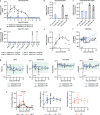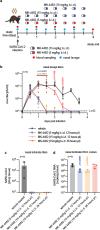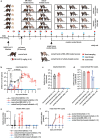This is a preprint.
Therapeutic MK-4482/EIDD-2801 Blocks SARS-CoV-2 Transmission in Ferrets
- PMID: 33052328
- PMCID: PMC7553152
- DOI: 10.21203/rs.3.rs-89433/v1
Therapeutic MK-4482/EIDD-2801 Blocks SARS-CoV-2 Transmission in Ferrets
Update in
-
Therapeutically administered ribonucleoside analogue MK-4482/EIDD-2801 blocks SARS-CoV-2 transmission in ferrets.Nat Microbiol. 2021 Jan;6(1):11-18. doi: 10.1038/s41564-020-00835-2. Epub 2020 Dec 3. Nat Microbiol. 2021. PMID: 33273742 Free PMC article.
Abstract
The COVID-19 pandemic is having a catastrophic impact on human health. Widespread community transmission has triggered stringent distancing measures with severe socioeconomic consequences. Gaining control of the pandemic will depend on interruption of transmission chains until protective herd immunity arises. Ferrets and related members of the weasel genus transmit SARS-CoV-2 efficiently with minimal clinical signs, resembling spread in the young-adult population. We previously reported an orally efficacious nucleoside analog inhibitor of influenza viruses, EIDD-2801 (or MK-4482), that was repurposed against SARS-CoV-2 and is in phase II/III clinical trials. Employing the ferret model, we demonstrate in this study high SARS-CoV-2 burden in nasal tissues and secretions that coincides with efficient direct-contact transmission. Therapeutic treatment of infected animals with twice-daily MK-4482/EIDD-2801 significantly reduced upper respiratory tract SARS-CoV-2 load and completely suppressed spread to untreated contact animals. This study identifies oral MK-4482/EIDD-2801 as a promising antiviral countermeasure to break SARS-CoV-2 community transmission chains.
Conflict of interest statement
Competing Interests Declaration
The authors declare no competing interests.
Figures






References
Publication types
Grants and funding
LinkOut - more resources
Full Text Sources
Miscellaneous

